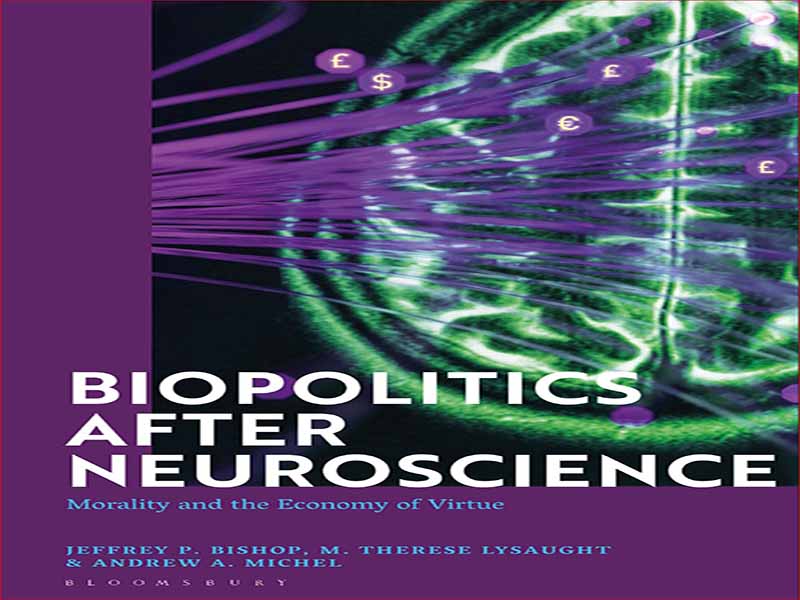- عنوان کتاب: Biopolitics After Neuroscience
- نویسنده/انتشارات: Jeffrey P. Bishop
- حوزه: علوم اعصاب
- سال انتشار: 2022
- تعداد صفحه: 305
- زبان اصلی: انگلیسی
- نوع فایل: pdf
- حجم فایل: 3.53 مگابایت
از آغاز هزاره جدید، ادبیات عامه پسندی که پیوندهای بین علوم اعصاب، هویت انسانی و به ویژه اخلاق را مورد بررسی قرار می دهد، به صورت قارچ گونه رشد کرده است. برای مثال، ژن های شیطانی باربارا اوکلی را در نظر بگیرید: چرا روم سقوط کرد، هیتلر رز، انرون شکست خورد و خواهرم دوست پسر مادرم را دزدید، که از «تصاویر پیشرفته مغز در حال کار استفاده می کند. . . نه تنها بر دیکتاتورهای دوردست، بلکه بر سیاست در داخل کشور، تجارت، مذهب و زندگی روزمره روشن می شود». یا Dean Haycock’s Murderous Minds: Exploring the Criminal Psychopathic Brain: Neurological Imaging and the Manifestation of Evil، که یافته هایی را از تصویربرداری عصبی و مطالعات رفتاری به دست می آورد تا مبنای بیولوژیکی فرضی شر را بررسی کند. کتاب «نجواگر روانپریشی: علم کسانی که وجدان ندارند» اثر کنت ای. و لیست می تواند ادامه یابد. شرارت، دزدی، روابط جنسی، قتل، وجدان – اینها به طور سنتی در حوزه تئوری اخلاقی بوده اند. اما در جایی که سنتهای اخلاقی تاریخی مدتها این رفتارها، ظرفیتها یا ویژگیها را بهعنوان محصولات شکلگیری اجتماعی، عادتسازی و اراده میدانستند، عصبشناسی معاصر بهراحتی اخلاق را در مغز جای میدهد. بنابراین، ما مجموعه سه جلدی والتر سینو-آرمسترانگ را در مورد روانشناسی اخلاقی می یابیم – که به عنوان علوم اعصاب شناختی بیولوژیکی بازنگری شده است – که هر جلد بر جنبه ای از اخلاق تمرکز دارد. یا اعتماد مغزی پاتریشیا چرچلند: آنچه علوم اعصاب درباره اخلاق به ما میگوید یا مغزهای مذهبی ما اثر رالف مکلنبرگر: آنچه علم شناختی درباره باور، اخلاق، اجتماع و رابطه ما با خدا آشکار میکند. باز هم لیست می تواند ادامه یابد. یکی پس از دیگری وعده می دهد که به ما بگوید ما کیستیم یا چیستیم و چرا کارهایی را که انجام می دهیم انجام می دهیم. در عوض، این عناوین محبوب محور مرکزی مجموعه علمی-صنعتی-دولتی است که علوم اعصاب معاصر است. در 2 آوریل 2013، باراک اوباما، رئیسجمهور ایالات متحده، ابتکار BRAIN (تحقیقات مغز از طریق پیشرفت فناوریهای عصبی نوآورانه) (BI) را اعلام کرد، یک همکاری دوازده ساله عمومی و خصوصی که به دنبال «انقلابی کردن درک ما از مغز انسان» است. ” اهداف BI از اهداف بلندپروازانه – نقشه برداری از ده میلیارد نورون در مغز انسان – تا مقدماتی بیشتر – توسعه یک “کانکتوم عملکردی” است. هزینه های هدف برای BI تقریباً 4.5 میلیارد دلار فقط برای بخشی از پروژه در نظر گرفته شده برای مؤسسه ملی بهداشت (NIH) برآورد شده است. BI جدیدترین پروژه علوم بزرگ است که شتاب فرهنگی و علمی را از جام مقدس پروژه ژنوم انسانی (HGP) دور می کند. جایی که نیمه دوم قرن بیستم به عنوان عصر ژن توصیف شده است، که در تصویر نمادین مارپیچ دوگانه ثبت شده است، قرن بیست و یکم تاکنون به عصر مغز تبدیل شده است که در عصر حاضر در همه جا منتقل شده است. تصویر اسکن مغز fMRI از اواخر دهه 1990، شاهد رشد تصاعدی مجلات علمی، کتابهای مشهور، مراکز تحقیقاتی و غیره بودهایم که همگی بر پتانسیلهای بکر مغز تمرکز دارند. BI نسخه قبلی خود – HGP – را به طور صریح و ضمنی در تعدادی از سطوح تکرار می کند. مکرراً می شنویم که BI این پتانسیل را دارد که همان کاری را که HGP برای ژنومیک انجام داد، برای علوم اعصاب انجام دهد. تشابهات بین آنها به قدری تنگ است که فرانسیس کالینز، مدیر NIH و مدیر سابق HGP، پرزیدنت اوباما را در بیانیه آوریل 2013 همراهی کرد.
Since the turn of the new millennium, popular literature exploring connections between neuroscience, human identity, and particularly morality has mushroomed. Consider, for example, Barbara Oakley’s Evil Genes: Why Rome Fell, Hitler Rose, Enron Failed and My Sister Stole My Mother’s Boyfriend, which uses “cutting edge images of the working brain to . . . shed light not only on dictators far afield, but on politics at home, as well as business, religion, and everyday life”; or Dean Haycock’s Murderous Minds: Exploring the Criminal Psychopathic Brain: Neurological Imaging and the Manifestation of Evil, which draws findings from neurological imaging and behavioral studies to probe the putative biological basis of evil. Kent A. Kiehl’s The Psychopath Whisperer: The Science of Those without Conscience similarly uses fMRI studies to show how prisoners’ brains work differently from our own. And the list could continue. Evil, theft, sexual liaisons, murder, conscience—these have traditionally been the purview of moral theory. But where historic moral traditions long understood these behaviors, capacities, or characteristics as products of social formation, habituation, and will, contemporary neuroscience straightforwardly locates morality in the brain. Thus, we find Walter Sinnot-Armstrong’s three-volume series on moral psychology—recast as biological cognitive neuroscience—with each volume focusing on some aspect of morality. Or Patricia Churchland’s Braintrust: What Neuroscience Tells Us about Morality or Ralph Mecklenburger’s Our Religious Brains: What Cognitive Science Reveals about Belief, Morality, Community and Our Relationship with God. Again the list could continue. Tome after tome promises to tell us who or what we are and why we do the things we do.This presumption that morality is a product of brain chemistry is not simply an artifact of the popular press or mass media. Rather, these popular titles capture a central thrust of the scientific-industrial-government complex that is contemporary neuroscience. On April 2, 2013, US president Barack Obama announced the BRAIN (Brain Research through Advancing Innovative Neurotechnologies) Initiative (BI), a twelve-year, public–private collaborative that seeks to “revolutioniz[e] our understanding of the human brain.” Aims of the BI range from the ambitious—mapping the estimated ten billion neurons in the human brain—to more the preliminary—developing a “functional connectome.” Target costs for the BI are estimated at approximately $4.5 billion solely for the portion of the project earmarked for the National Institutes of Health (NIH). The BI is the most recent Big Science project, shifting cultural and scientific momentum away from the Holy Grail of the Human Genome Project (HGP). Where the second half of the twentieth century has been characterized as the Age of the Gene, captured in the iconic image of the double-helix, the twenty-first century thus far has become the Age of the Brain, conveyed in the now-ubiquitous image of the fMRI brain scan. Since the late 1990s, we have witnessed the exponential growth of scientific journals, popular books, research centers, and more, all focusing on the untapped potential of the brain. The BI reprises its predecessor—the HGP—both explicitly and implicitly on a number of levels. Repeatedly, we hear that the BI has the potential to do for neuroscience what the HGP did for genomics. So tight are the parallels between them that Francis Collins, NIH director and former director of the HGP, accompanied President Obama in his April 2013 announcement.
این کتاب را میتوانید از لینک زیر بصورت رایگان دانلود کنید:
Download: Biopolitics After Neuroscience



































نظرات کاربران